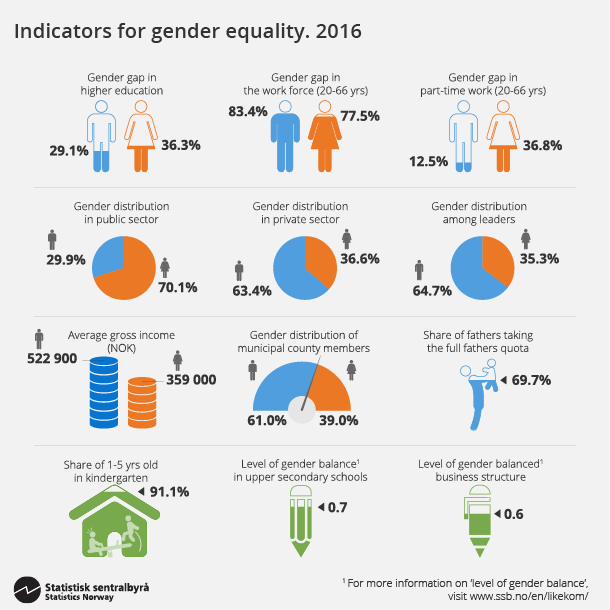Gender-divided labour market
Published:
Updated:
The gender-divided labour market is one of the biggest challenges in achieving full gender equality in Norway, but the disparities in the labour market vary in different counties.
- Full set of figures
- Indicators for gender equality in municipalities
- Series archive
- Indicators for gender equality in municipalities (archive)
Statistics Norway's twelve indicators of gender equality show that the labour market in Norway is highly gender divided. A gender-divided labour market entails the inequality of women and men in working life. For example, women and men work in different sectors and industries, women are more likely to work part time than men, and a greater proportion of men are managers. These disparities can partly be due to women and men making different educational choices as early as upper secondary School, according to updated figures from The indicators for gender equality.
The gender equality indicators describe gender equality at national and local level by providing a measure of equality/inequality between women and men (see fact box for more details). Nationally, there has been a trend towards more gender equality on most indicators since Statistics Norway published them for the first time in 2008. The gender-divided labour market is also subject to geographic disparities; there are large gender disparities between employees in different counties and municipalities.
Gender-divided public sector in Western counties
In Western Norway, the gender disparity among employed persons is particularly high in public sector. In Rogaland, Møre og Romsdal and Sogn og Fjordane, about 75 per cent of employed persons in the public sector are women. The remaining 25 per cent are men. These three counties have the lowest score on the indicator that measures gender distribution among employees in the public sector.
Figure 1. Gender distribution among employed in the public sector. Average for the whole country and selected counties. 2016
| Men | Women | |
| Møre og Romsdal | 25.2 | 74.8 |
| Rogaland | 24.7 | 75.3 |
| Sør-Trøndelag | 32 | 68 |
| Oslo | 35.7 | 64.3 |
| Entire country | 29.9 | 70.1 |
Gender distribution among employed persons is not as unevenly distributed in the private sector as in the public sector. On the indicator that measures gender distribution among employed persons in the private sector, Sogn og Fjordane has the lowest score, followed by Finnmark and Nordland. In Sogn og Fjordane, 69 per cent of those employed in the private sector are men, and the rest are women.
Figure 2. Gender distribution among employed in the private sector. Average for the whole country and selected counties. 2016
| Men | Women | |
| Sogn og Fjordane | 68.7 | 31.3 |
| Nordland | 67.2 | 32.8 |
| Hordaland | 62.9 | 37.1 |
| Oslo | 57.8 | 42.2 |
| Entire country | 63.4 | 36.6 |
Oslo is the county where both the public and private sectors are least dominated by one of the sexes. In the public sector, 64 per cent of employed persons are women, while the remaining 36 per cent are men. In the private sector, 58 per cent of employed persons are men and the rest are women. Behind Oslo, follow Akershus and Hordaland.
Oslo women work less part time
At the national level, the indicator that measures the ratio of employed women to men in part-time work has the lowest score. In the counties, Oslo and Finnmark score the highest. This means that the disparity in the proportion of men and women working part time is smallest in these counties.
However, there are various reasons why Oslo and Finnmark have a high score on the part-time indicator. In Oslo, the proportion of women working part time is the lowest in the country, while the proportion of men working part time is relatively high compared with men in other counties. In Finnmark, the proportion of women and men working part time is quite low compared with women and men in other counties – which also offsets the gender disparity.
In Akershus, the proportion of women working part time is the smallest in Norway after Oslo, but the county does not have a very high score on the part-time indicator. The reason for this is that the proportion of men in Akershus who work part time is the lowest in the country.
Most gender equality in Oslo and Akershus
Oslo and Akershus score high on many of the indicators, and Troms and Finnmark also have many high scores.
It is not surprising that Oslo and Akershus score high on many of the indicators. Many of those living in or around the capital have a higher education, and the number of employers is high.
For example, in Oslo, 40 per cent of all women are managers. This is the largest proportion in the whole country. Akershus comes a close second with 38 per cent. By comparison, only 31-32 per cent of managers are women in Vestfold, Vest-Agder and Aust-Agder. This is largely because the proportion of female managers is particularly low in some of the municipalities, which reduces the average for the counties. At the national level, however, there has been a gradual increase in the proportion of female managers since 2008, and also municipal government representatives.
Men and women in Finnmark have the most equal Income
On the indicator for gender distribution of economic resources, measured by average gross income, Finnmark has the highest score – followed by Troms and Hedmark. In Finnmark, the income level for women is relatively high compared to women in other counties. Men from Finnmark, on the other hand, have the lowest income throughout the country compared to men in other counties. This results in the income of women and men being more equal, and the gender disparity less.
Figure 3. Women's and men's average gross income, by county. In kroner. 2016
| Men | Women | |
| Finnmark | 355500 | 442600 |
| Troms | 359000 | 475400 |
| Nordland | 342200 | 462800 |
| Nord-Trøndelag | 329800 | 456700 |
| Sør-Trøndelag | 353400 | 504800 |
| Møre og Romsdal | 334700 | 501800 |
| Sogn og Fjordane | 339300 | 476500 |
| Hordaland | 354000 | 528600 |
| Rogaland | 363400 | 584300 |
| Vest-Agder | 325300 | 491800 |
| Aust-Agder | 325700 | 496000 |
| Telemark | 328800 | 473300 |
| Vestfold | 339700 | 506100 |
| Buskerud | 352000 | 517200 |
| Oppland | 333900 | 453300 |
| Hedmark | 332700 | 446700 |
| Oslo | 410200 | 589500 |
| Akershus | 401400 | 603500 |
| Østfold | 330500 | 468900 |
| Entire country | 359000 | 522900 |
As mentioned, Oslo and Akershus score high on many of the twelve indicators. One of the exceptions is income, where gender disparities are relatively high, although income levels are high for both women and men. Especially in Akershus, both women and men have higher incomes than in other parts of the country, but the income for men in Akershus is at a very high level - which results in relatively large gender disparities.
Rogaland is the county where gender disparities in income are greatest, but right behind is Aust- and Vest-Agder. The income level is high for both women and men, but the income for men in Rogaland is at a very high level. This results in relatively large gender disparities. The trend in Rogaland is also seen in the income of women and men in Oslo and Akershus.
For other indicators of gender equality that are included in the indicator set or figures for other counties and municipalities than those mentioned in the article, see Statbank.
Contact
-
Karin Hamre
-
Statistics Norway's Information Centre


